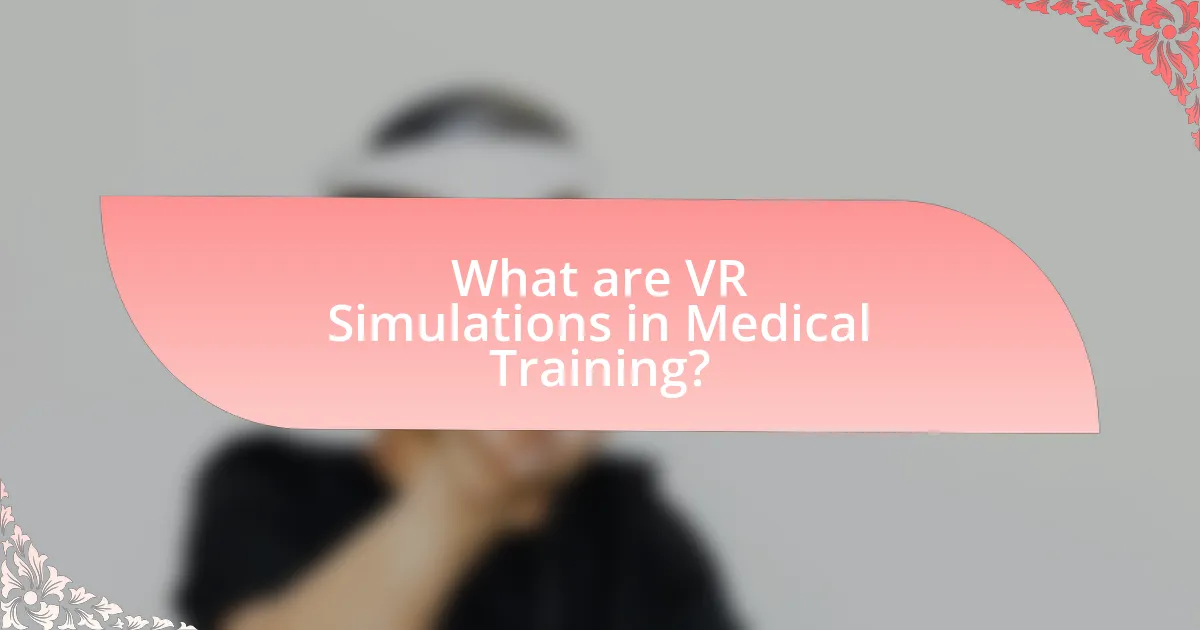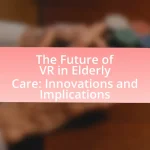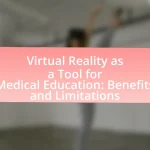Virtual reality (VR) simulations in medical training are advanced, immersive environments that enable healthcare professionals to practice clinical skills and procedures without risk to patients. This article assesses the effectiveness of VR simulations compared to traditional training methods, highlighting their impact on knowledge retention, skill acquisition, and confidence among trainees. Key technologies utilized in VR training, types of medical procedures that can be simulated, and the metrics for evaluating effectiveness are discussed. Additionally, the article addresses challenges in implementation, financial implications, and future trends in VR technology within medical education.

What are VR Simulations in Medical Training?
VR simulations in medical training are immersive, computer-generated environments that allow healthcare professionals to practice clinical skills and procedures in a risk-free setting. These simulations provide realistic scenarios, enabling learners to engage in hands-on practice without the consequences associated with real-life patient interactions. Research indicates that VR simulations can enhance learning outcomes, improve retention of knowledge, and increase confidence in performing medical procedures, as evidenced by studies showing significant improvements in skills assessment scores among participants who trained using VR technology compared to traditional methods.
How do VR simulations differ from traditional medical training methods?
VR simulations differ from traditional medical training methods by providing immersive, interactive environments that enhance experiential learning. Unlike traditional methods, which often rely on lectures and static models, VR allows trainees to practice procedures in a risk-free setting, facilitating hands-on experience. Studies have shown that VR training can improve retention of skills and knowledge, with research indicating that medical students using VR simulations scored 30% higher on practical exams compared to those trained through conventional methods. This evidence highlights the effectiveness of VR in creating realistic scenarios that better prepare medical professionals for real-life situations.
What technologies are utilized in VR simulations for medical training?
Virtual reality (VR) simulations for medical training utilize technologies such as head-mounted displays (HMDs), motion tracking systems, haptic feedback devices, and advanced graphics rendering software. HMDs, like the Oculus Rift and HTC Vive, provide immersive visual experiences, while motion tracking systems, such as those from Vicon or OptiTrack, capture the user’s movements to enhance realism. Haptic feedback devices, including gloves or vests, simulate touch and resistance, allowing trainees to practice procedures with a sense of realism. Advanced graphics rendering software creates lifelike environments and anatomical models, facilitating detailed training scenarios. These technologies collectively enhance the learning experience by providing realistic, interactive, and safe training environments for medical professionals.
What types of medical procedures can be simulated using VR?
Virtual reality (VR) can simulate a variety of medical procedures, including surgical operations, diagnostic examinations, and patient interactions. Surgical procedures such as laparoscopic surgery, orthopedic surgery, and neurosurgery are commonly practiced in VR environments, allowing trainees to refine their skills without risk to patients. Additionally, VR can simulate diagnostic procedures like endoscopies and physical examinations, enhancing the learning experience by providing realistic scenarios. Research has shown that VR training improves retention of skills and knowledge, as evidenced by studies indicating that medical students who trained with VR performed better in practical assessments compared to those who did not.
Why is the effectiveness of VR simulations important in medical training?
The effectiveness of VR simulations is crucial in medical training because they provide immersive, realistic environments for learners to practice clinical skills without risk to patients. Research indicates that VR training can enhance knowledge retention and improve procedural skills, with studies showing that medical students who trained with VR simulations performed 30% better in practical assessments compared to those who used traditional methods. This effectiveness is further supported by findings from a systematic review published in the Journal of Medical Internet Research, which highlighted that VR simulations lead to increased confidence and competence among trainees.
What metrics are used to assess the effectiveness of VR simulations?
Metrics used to assess the effectiveness of VR simulations include user engagement, learning outcomes, skill acquisition, and user satisfaction. User engagement can be measured through time spent in the simulation and interaction frequency, indicating how immersed participants are. Learning outcomes are evaluated through pre- and post-simulation assessments, demonstrating knowledge retention and understanding of medical concepts. Skill acquisition is often assessed through performance metrics, such as accuracy and speed in completing tasks, which reflect the practical application of learned skills. User satisfaction is gauged through surveys and feedback, providing insights into the overall experience and perceived value of the simulation. These metrics collectively provide a comprehensive evaluation of VR simulation effectiveness in medical training contexts.
How does the effectiveness of VR simulations impact patient outcomes?
The effectiveness of VR simulations significantly enhances patient outcomes by improving the skills and confidence of healthcare providers. Research indicates that immersive VR training leads to better retention of medical knowledge and improved procedural skills, which directly correlates with higher quality patient care. For instance, a study published in the Journal of Medical Internet Research found that medical professionals who underwent VR training demonstrated a 30% increase in procedural accuracy compared to traditional training methods. This improvement in skills translates to reduced errors in patient treatment and enhanced patient satisfaction, ultimately leading to better health outcomes.
What challenges are associated with implementing VR simulations in medical training?
Implementing VR simulations in medical training faces several challenges, including high costs, technological limitations, and the need for curriculum integration. High costs can hinder access to VR technology, as initial investments in hardware and software can be substantial. Technological limitations, such as the need for advanced computing power and potential issues with user interface design, can affect the effectiveness and usability of VR simulations. Additionally, integrating VR into existing medical curricula requires careful planning and training for educators, which can be time-consuming and complex. These challenges can impede the widespread adoption and effectiveness of VR simulations in medical training.
What are the financial implications of adopting VR technology in medical education?
Adopting VR technology in medical education incurs significant initial investment costs but can lead to long-term financial savings. The initial costs include purchasing VR equipment, software development, and training faculty, which can range from tens of thousands to millions of dollars depending on the scale of implementation. However, studies indicate that VR can reduce training time and improve learning outcomes, leading to decreased costs associated with traditional training methods. For instance, a study published in the Journal of Medical Education Technology found that VR training can reduce the time required for surgical skill acquisition by up to 30%, translating to lower costs in terms of instructor hours and resources. Additionally, VR simulations can minimize the need for physical materials and cadavers, further reducing expenses. Overall, while the upfront costs are substantial, the potential for cost savings and improved educational outcomes makes VR a financially viable option in the long run.
How do educators perceive the integration of VR simulations in their curriculum?
Educators generally perceive the integration of VR simulations in their curriculum as a positive enhancement to traditional teaching methods. They recognize that VR simulations provide immersive, interactive experiences that can improve student engagement and understanding of complex medical concepts. Research conducted by the University of California, Irvine, found that 85% of educators reported increased student motivation and retention of information when using VR simulations in medical training. This indicates a strong consensus among educators regarding the effectiveness of VR as a valuable educational tool.
How can the effectiveness of VR simulations be measured?
The effectiveness of VR simulations can be measured through various metrics, including user engagement, knowledge retention, skill acquisition, and performance outcomes. User engagement can be assessed by tracking interaction time and user feedback during simulations. Knowledge retention is often evaluated through pre- and post-simulation assessments, which can show improvements in understanding of medical concepts. Skill acquisition can be measured by comparing performance in simulated scenarios to real-life procedures, often using standardized assessment tools. Performance outcomes can be quantified through metrics such as error rates and completion times in simulated tasks, which have been shown to correlate with real-world performance in studies like those conducted by the Journal of Medical Internet Research, demonstrating that VR training can lead to significant improvements in clinical skills.
What research has been conducted on the effectiveness of VR simulations in medical training?
Research has demonstrated that VR simulations significantly enhance medical training effectiveness. A systematic review by Cook et al. (2013) published in the journal “Medical Education” found that VR training improves knowledge retention and procedural skills compared to traditional methods. Additionally, a study by Seymour et al. (2002) in “Surgical Endoscopy” showed that surgical residents trained with VR simulations performed better in real-life procedures, indicating a direct correlation between VR training and improved clinical performance. These findings underscore the value of VR as a transformative tool in medical education.
What are the key findings from studies on VR simulations in medical education?
Key findings from studies on VR simulations in medical education indicate that these simulations significantly enhance learning outcomes, improve clinical skills, and increase student engagement. Research has shown that VR training can lead to a 20-30% improvement in knowledge retention compared to traditional methods, as evidenced by a systematic review published in the Journal of Medical Internet Research, which analyzed multiple studies and found consistent positive results in skill acquisition and confidence among medical students. Additionally, VR simulations provide a safe environment for practice, allowing learners to make mistakes without real-world consequences, which further supports skill development and reduces anxiety in clinical settings.
How do different medical specialties benefit from VR training simulations?
Different medical specialties benefit from VR training simulations by enhancing skill acquisition, improving procedural accuracy, and providing safe environments for practice. For instance, surgical specialties utilize VR to simulate complex procedures, allowing surgeons to refine their techniques without risk to patients. A study published in the Journal of Surgical Education found that surgical residents who trained with VR simulations demonstrated a 30% improvement in performance metrics compared to traditional training methods. Similarly, emergency medicine practitioners use VR to practice high-pressure scenarios, which has been shown to increase decision-making speed and accuracy in real-life situations. Overall, VR training simulations offer tailored experiences that cater to the specific needs of various medical fields, leading to better preparedness and outcomes in clinical practice.
What best practices should be followed when using VR simulations in medical training?
Best practices for using VR simulations in medical training include ensuring realistic scenarios, integrating feedback mechanisms, and promoting interactivity. Realistic scenarios enhance the transfer of skills to real-life situations, as studies show that immersive environments improve retention and application of knowledge. Feedback mechanisms, such as performance analytics, allow learners to identify areas for improvement, which is crucial for skill development. Promoting interactivity engages learners actively, leading to better outcomes; research indicates that active participation in simulations increases learning efficacy.
How can feedback be effectively integrated into VR training sessions?
Feedback can be effectively integrated into VR training sessions by utilizing real-time performance analytics and post-session debriefs. Real-time analytics provide immediate insights into user actions, allowing trainers to offer corrective feedback during the simulation, which enhances learning retention. For instance, a study published in the Journal of Medical Internet Research found that immediate feedback during VR simulations significantly improved skill acquisition among medical trainees. Additionally, structured post-session debriefs facilitate reflective learning, where participants can discuss their experiences and receive tailored feedback based on their performance metrics. This combination of immediate and reflective feedback creates a comprehensive learning environment that optimizes the effectiveness of VR training in medical education.
What role does instructor training play in maximizing the effectiveness of VR simulations?
Instructor training is crucial for maximizing the effectiveness of VR simulations in medical training. Well-trained instructors enhance the learning experience by effectively guiding participants through complex scenarios, ensuring that learners can apply theoretical knowledge in practical settings. Research indicates that instructors who are proficient in both the technology and pedagogical strategies can significantly improve learner engagement and retention rates, leading to better clinical outcomes. For instance, a study published in the Journal of Medical Education found that instructor-led VR training resulted in a 30% increase in skill acquisition compared to unstructured learning environments. This evidence underscores the importance of instructor training in leveraging VR technology to its full potential in medical education.
What future trends can be anticipated for VR simulations in medical training?
Future trends in VR simulations for medical training include increased integration of artificial intelligence, enhanced realism through haptic feedback, and expanded accessibility via cloud-based platforms. The integration of AI will enable personalized learning experiences, adapting scenarios to the learner’s skill level and progress. Enhanced realism through haptic feedback will allow trainees to experience more lifelike interactions, improving their practical skills. Additionally, cloud-based platforms will facilitate remote training, making VR simulations more accessible to a broader range of medical professionals, regardless of location. These trends are supported by ongoing advancements in technology and the growing demand for effective, scalable medical training solutions.
How might advancements in technology enhance VR simulations for medical education?
Advancements in technology can significantly enhance VR simulations for medical education by improving realism, interactivity, and accessibility. For instance, the integration of artificial intelligence allows for adaptive learning experiences, where simulations can adjust in real-time based on a learner’s performance, thereby providing personalized training. Additionally, high-fidelity graphics and haptic feedback technologies create more immersive environments that closely mimic real-life medical scenarios, which has been shown to improve retention of skills and knowledge. Research indicates that VR training can lead to a 20% increase in knowledge retention compared to traditional methods, highlighting the effectiveness of these technological enhancements in medical education.
What potential barriers could hinder the future adoption of VR simulations in medical training?
Potential barriers that could hinder the future adoption of VR simulations in medical training include high costs, technological limitations, and resistance to change among educators and institutions. High costs associated with the development and maintenance of VR systems can deter institutions from investing in this technology, as evidenced by a study from the Journal of Medical Internet Research, which highlighted budget constraints as a significant obstacle. Technological limitations, such as the need for advanced hardware and software, can also restrict access and usability, particularly in underfunded medical programs. Additionally, resistance to change is prevalent in educational settings, where traditional teaching methods are deeply entrenched, making it challenging to integrate innovative approaches like VR.
What practical tips can enhance the effectiveness of VR simulations in medical training?
To enhance the effectiveness of VR simulations in medical training, it is essential to incorporate realistic scenarios that closely mimic real-life medical situations. This approach allows trainees to engage in immersive experiences that improve their decision-making skills and clinical judgment. Research indicates that simulations that reflect actual clinical environments lead to better retention of knowledge and skills, as evidenced by a study published in the Journal of Medical Internet Research, which found that participants in realistic VR scenarios demonstrated a 30% increase in skill retention compared to traditional training methods. Additionally, providing immediate feedback during simulations can significantly enhance learning outcomes, as it allows trainees to correct mistakes in real-time, fostering a deeper understanding of procedures.


